Roman Ondak
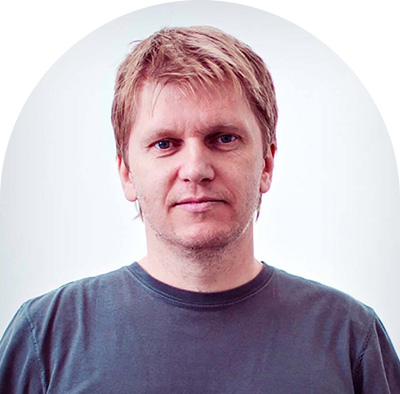
Roman Ondak
Roman Ondak (*1966, Žilina) is one of the most outstanding contemporary artists in Slovakia. A representative of world-class conceptual art, he managed to establish a name for himself with his work among the most prestigious institutions and collections abroad. He works with shifting reality and staging its reflections in original settings. His work if often open to collaboration and interplay with the viewer. The subjective reality is sensitively transformed into new meanings in unexpected places. Ondak reflects on what has the potential to become art, and the differences in how it can be viewed by the individual. His work utilises a combination of traditional techniques of drawing, photography, sculptural object and installation, and new media, including video and unique performance art. It often reacts to current social and cultural events, interpersonal relationships and situations from everyday life. After graduating from the Academy of Fine Arts and Design in Bratislava in 1994, he completed several study stays abroad. Ondak has exhibited his works at the Tate Modern in London, MoMA in New York, Deutsche Guggenheim in Berlin, and Musée d’Art Moderne de la Ville de Paris in Paris. He was also featured at the Venice Biennale, where he had previously exhibited a highly successful, independent project Loop for the Czech and Slovak pavilion. His works are present in the collections of renowned galleries, including MoMA in New York, Guggenheim Museum New York, Musée National d’Art Moderne in Paris, Pinakothek der Moderne Munich, and Tate Modern in London. He lives and works in Bratislava.
Time Capsule
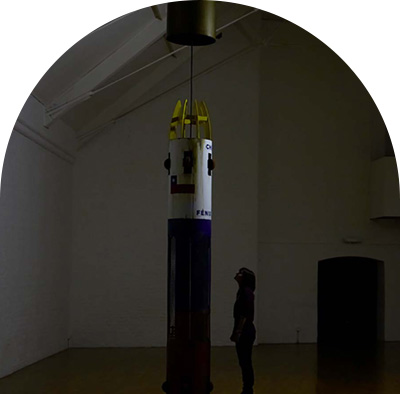
Time Capsule
The large-scale Time Capsule (2011) installation is one of the most representative gallery pieces by the Slovak artist Roman Ondak (1966). Based on technical blueprints, the author has created a full-scale replica of the Fénix 2 capsule used in 2010 to rescue 33 Chilean miners. An accident caused them to be trapped at a depth of 700 metres for 69 days, while their fight for survival and dramatic rescue was followed by millions of people around the world. Roman Ondak was fascinated by the mass media coverage of the rescue of the miners in Chile, and decided to place the form of the depth capsule in the context of art as a symbol for hope and solidarity. The work pays tribute to several of his projects that totally dominate the gallery space, transcending the boundaries of exhibition space by playing with the meaning of artistic and extra-artistic reality, fascination with time, scientific research, but also the media paradox in a globalised world. The technical and structural aesthetics of the object and its sculptural quality are loosely reminiscent of some well-known utopian projects of Slovak conceptual art of the 1960s and 1970s, which were related to cosmic themes, and the future of humanity. The work was displayed in Ondak’s solo exhibition in the UK (Modern Art Oxford, 2011), and at the 54th Venice Biennale (Arsenale, 2011). Time Capsule is of particular significance to the Slovak National Gallery (SNG) collections because Ondak uses it to turn his gaze back to Earth, and quietly yet urgently invites us to dive into the depths of our own humanity. It has the impact of a monumental sculpture, one in which Ondak materialised much of his long-standing enquiry concerning the subject of time. This includes his critical thinking on the issue of media and the present-day, information-saturated culture. From all the available coverage, he chose the moment where scientists, engineers, politicians and the media came together to save the victims of the mine accident. He put it inside the Time Capsule for us as a humanist message for the future.
Erik Binder
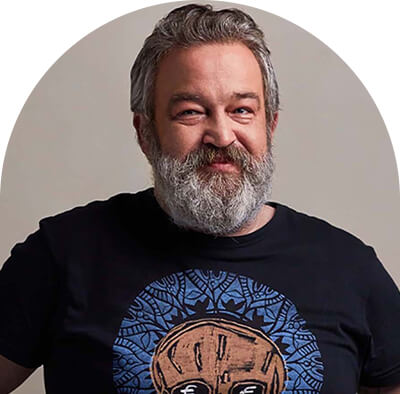
Erik Binder
Erik Binder (1974) works across practically all media, from drawing, painting, graphics, through objects and installations, to performance, including working with music, sound and poetry. He studied at the Academy of Fine Arts and Design in Bratislava, and the Academy of Fine Arts in Prague. Binder lives, works, receives and broadcasts in Bratislava. Art is for Erik his way of being in the world – the way he approaches things, words and thoughts. The defining principle of his work is in the nearly constant and spontaneous transformation of situations and materials. He frequently and happily invites the principle of chance and accidents into his creative process. Binder tries to minimise the amount of decisions he makes, to the point of “vanishing, yet still affecting it”. For him, inspiration comes from subcultures such as hip hop, skateboarding and street art, having in common that new works within their context are not created ex nihilo, but rather as a rearrangement, layering and mixing of already existing elements. Similarly, Binder functions as a “Visual DJ” or “Selector”. His approach to materials is unintentionally ecological and anti-elitist in his approach – rubbish, or any “low-end” objects – become full-fledged, raw artistic material in his hands. Discarded materials are recycled or “re-used”, i.e. they get a new spin on the cycle of life. This puts growth and creation, as well as decay and destruction, on an equal footing. The author’s work fulfils the avant-garde idea of merging art with life, as well as merging the viewer with the art. His ideal spectator is willing to take a step from passive “onlooking” to a more active and creative “perception”, and thus complete the work with their own story.
Pneumatrix
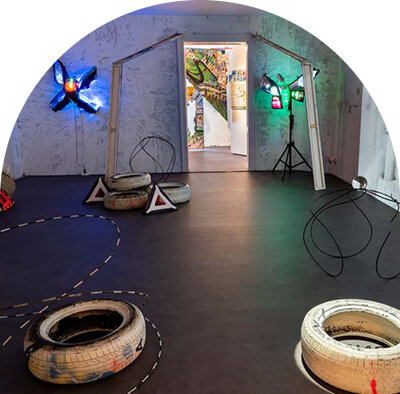
Pneumatrix
The Pneumatrix (2016) video installation was created in close collaboration with several close associates for the exhibition of the same name in Košice, about a year before the car accident which had a fundamental transformational significance for Erik Binder. According to curator Petr Tajkov, the leitmotif of the exhibition was the symbol of our modern life journey, full of pitfalls and obstacles. Used tyres created the Pneumatrix – a microcosm where this symbol of environmental burden is given a new, white life. The unsustainable consumerism of our society, and its greed, becomes the main theme of the work which is an audiovisual contemplation of one’s purification, freeing oneself from materialistic desires. The outline of the human body is also a gateway to the metaphysical realm (Same, Same but Different – Golem, 2014), which also includes the luminous Transformer butterflies that have emerged from the ruins of used cars (2018) and thus, according to the author, have already flown hundreds of thousands of kilometres. In Stoic philosophy, “pneuma” (πνεῦμα) is the concept of the breath of life, as the active, generative principle behind both the individual and the cosmos, giving matter its shape and properties. In its highest form, pneuma defines the human soul (psyche). The word pneuma is the Greek translation of the Hebrew word “ruah” in biblical literature. It has several meanings: air, wind, soul, breath, vital principle. The word “matrix” refers to the cult film that has captured the imagination of pop culture at the turn of the millennium. Escaping the matrix and learning the truth is painful, it requires radical change. Within the Pneumatrix, this is the child breaking down the old order within the person who is reborn into a new childhood (renatus in novam infantiam).
Marko Blažo
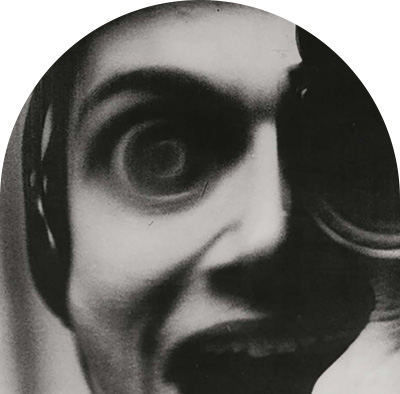
Marko Blažo
The unexpected oeuvre left behind by the Košice artist Marko Blažo (1972 – 2021) is one of the most original and consistent of his generation. Following his graphic training at the School of Applied Arts (ŠUP) in Košice, Blažo studied at the beginning of the 1990s at the Academy of Fine Arts and Design (VŠVU) in the quasi-free “open studio” of Rudolf Sikora. In the decade shortly after the revolution, when society was still curious about new forms of art, and the creativity of the young was still vibrant, Blažo’s presentations (e.g. chewing gum “paintings” or various surreal objects and situational “game” installations) were immediately recognised for their distinctive poetics. It was a rich and romantic, yet deeply melancholic world. As far as paintings are concerned, it was not “Realist painting”, but rather one made by drawing or colouring in. Its nature was conceptual – the “gains” for the viewer lay in the particular constellation of the returning motifs and their associative power. There was a layering and cycling of subjects, including trains, construction kits; and links to archaeology, ancient and mediaeval architecture (pyramids, castles, scaffolding systems, sinkholes, simple churches and magnificent cathedrals), as well as to the children’s and adolescent world of “Ostalgia”. The artist drew from the sediments of global cultural heritage and art history, not excluding the Socialist visual experience. He worked using the motifs of this “memory bank” and endlessly, in an unusually inventive way, combined and composed them into new associations, which – having been later generated by his computer – have overcome any space-time limitations.
Yoga Scream
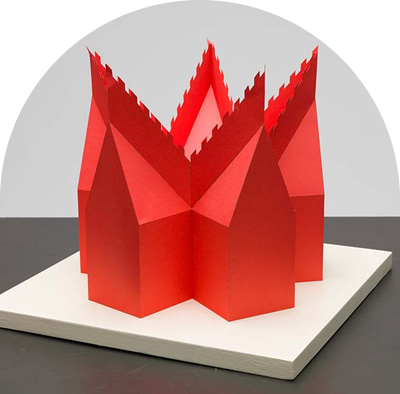
Yoga Scream
Yoga Scream represents one among several parallel areas of focus in Blažo’s work. The motif of the split cabbage head appears together with other objects repeatedly, in different variations and combinations, within his work – it becomes a continuation to the sea foam in the famous Hokusai graphic series, or overlaps with the contour lines of the map from the Genealogy series. The cabbage head holds various symbolic qualities besides its fascinating ornamental value, which Blažo was able to skilfully accentuate. In his case, we can therefore speak of a kind of “cabbage iconography”. The centre of this composition is a human face, borrowed from Munch’s famous The Scream, mounted on top of a body seated in the lotus position, with a trio of legs and arms growing organically into the vegetable structure. Its starting point is likely computer graphics transferred into the medium of painting. Blažo’s unmistakable ability to combine fragments of diverse visual information into a whole, which looks amusing or even humorous at first glance, is most evident here. Yet at the same time as its playfulness and wit, we can also perceive the claustrophobic density of the stacked leaves, and their twists and turns and ripples which resemble the human brain, and at the same time are a kind of a map, or a deformed mandala. Instead of clarity and order, we see a chaotic and oversaturated tangle of pathways; body and mind that are out of control, as if growing into unnatural dimensions and shapes, separating from the subject, and at the same time concentrating beyond tolerable levels. A tension that only the cathartic intensity of a scream can release. In all this there is the determination to face the confusion, to organise oneself and thus the whole world, to fold one’s body and attention in a yogic posture, and to change chaos into simplicity, and noise into silence, via meditation. A process that we are all going through a little these days.
Denisa Lehocká
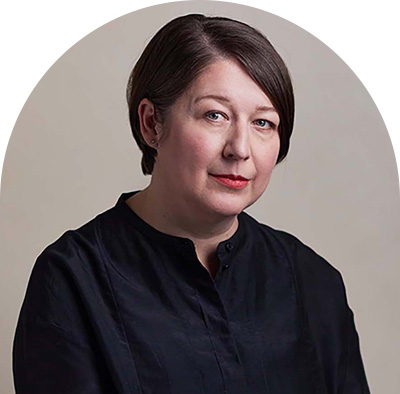
Denisa Lehocká
The work of Denisa Lehocká (1971), one of our most successful contemporary artists, defies language. It is as if the meaning contained within her work is the domain of pre-reflective experience – the domain of a body in motion, its visual and (imaginary) haptic sensations. We can observe several starting points that reveal partial information about the background of these works, yet not so much about the works themselves. One of these starting points is certainly her study of textiles at the secondary School of Applied Arts in Bratislava, as well as the subsequent years spent in the studio of Rudolf Sikora at The Academy of Fine Arts and Design (VŠVU) in Bratislava. Another clue can be found in the tradition of organic sculpture, and Lehocká’s affinity towards artists such as Eva Hesse, Eva Kmentová and Mária Bartuszová. One must also consider the period of Lehocká’s arrival on the scene (the 1990s), and the prevailing post-conceptual tendencies in the art of the time. Lehocká’s drawings, objects and installations evade any attempt at analysis, and are the kind of (relatively rare) art that negates attempts to rigidly adhere to a certain style or tradition. It can be said that Lehocká has been consistently developing her artistic programme for several decades. Or rather, her programme is actually a single work of art spread over time and space, which the author has been continuously weaving together and branching apart in an intuitive and associative manner. The slowness in the creation of her objects, the intuitiveness of her thinking, and the organic nature of her shapes may lead us towards associations with feminism, or archetypal feminine perception and creation of the world. Whilst using a number of sculptural, textile and painting techniques in her work, neither of them fully defines Lehocká. The result is primarily defined by the design, realisation and revitalisation of the space in which her work (usually spatial installations) is located.
untitled
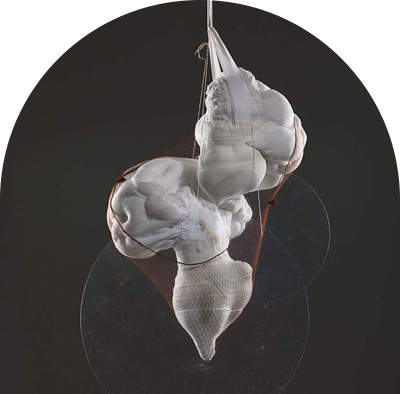
untitled
In his famous essay Inside the White Cube, one of the defining texts for critical art theory, Brian O’Doherty writes about the immense sanctifying power of the Art Museum, the most conventional format of which in the 20th century became the “white cube”. It is a kind of wondrous platform, an alchemical magic box, in which things transform and become more aesthetically symptomatic, and the audience more receptive. A kind of crystallisation of things and senses takes place here. The charm of the white cube and its politics have been questioned many times since then. The so-called institutional critique has ridiculed the transformative power of the museum as a “viewing machine” many times, classifying itself as a subject for art. Although the mainstream of artistic production has since moved on in a different direction, a certain part of art still exists and operates (!) within the white cube framework, and the work of Denisa Lehocká’s certainly belongs there. Otherwise, how would we be able to view and appreciate the qualities of three artefacts precisely configured inside a lofty room? Air and its currents between objects. The relation between vertical and horizontal lines, the weight of the suspended and the resting; structural, shape and material diversity of autonomous objects forming a spatial collage. How else would we come closer to the central object of Denisa’s composition and perceived its perverse, even “abject” virtue, and all its morphological and material tensions. Its cerebral and testicular qualities, its softness and solidity, its complexity and hybrid “composition”. The sediments of plaster and reflections of plexiglass, the cobweb form of a hairnet… If we didn’t believe in the existence of autonomous art (White Cube Art), we would just pass like indifferent agnostics, reinforcing the notion that art is some high-society prank.
Milan Tittel
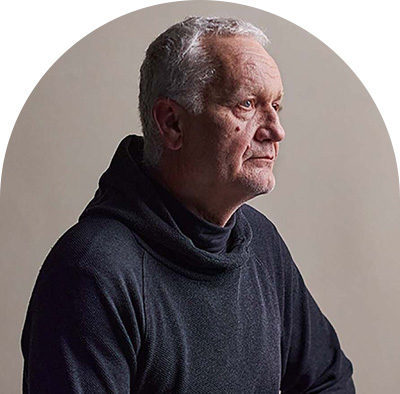
Milan Tittel
Milan Tittel (1966) is one of the most distinctive authors of his generation who, until recently, has been “hiding in the background” as a member of various art groups and collaborations. Luckily for us, curator Aurel Hrabušický has “discovered” him and brought him into the limelight. Although he works with multiple media (found objects, performance, video, …), his origins remain with the sculpture, which he studied at the Academy of Fine Arts and Design in Bratislava (VŠVU). His sculptural perception of space is also noticeable in the Karanténa / Quarantine photographic series (since 2020), which is a kind of a diary recording the days spent in isolation. At first glance, the abandoned spaces and open horizons in the photographs evoke a post-apocalyptic sadness, but they can also be interpreted the other way around – as symbols of freedom, tranquility and relief. Tittel’s object work is characterised by an intimate scale. The installation method is intentionally inconspicuous, so the challenge is the very discovery of the artwork. It calls for being within touching distance in order to fully appreciate the work. There is a beckoning for physical proximity, even touching perhaps. The objects created by Tittel are largely defined by the physical and haptic qualities of the material used – its softness or hardness, its lustre, its fragility. Although he does not create sculptures in the classical sense (in which the influence of his teacher, the experimenter with mixed media Vladimír Havrilla, is evident), the most important characteristic of his art remains the contact with the material. This is what makes the Krátky život (Short Life) and Dno (Bottom) series fascinating. In both cases these are almost identical copies of natural formations (butterflies, mushrooms), which the artist “re-creates” using artificial materials (PVC, silicone). It is as if experiencing physical contact with the objects (touching, arranging, or creating them) was a necessary precondition to their full understanding and appreciation – a path to unity.
Vernissage. 2000
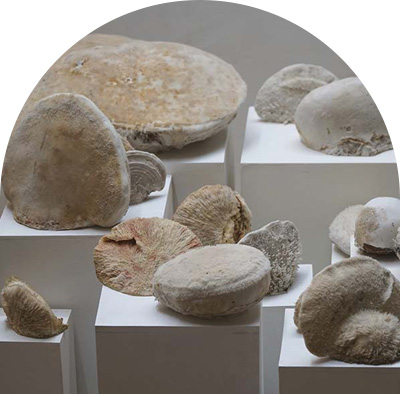
Vernissage. 2000
An apparent work of a single genre, almost upbeat, its form is deceptive and attracts viewers with its “unheimlich” quality, quite typical for the author. It could be a mock-up, but why is it so “withered”? Or a kind of voodoo object, a “doll’s house” that the artist “crafted” in his studio, and where he observes it and subjects it to various (thermal?) experiments… The material substance of the object is once again a mystery. It feels soft and rubbery, like a confectionery, inviting you to touch it, to “have a lick”. Even in its “gallery-like” dimension, the self-referring object of the Gallery is disturbingly associative. It makes us want to shrink to the size of the object, or zoom in on it, and thus become a part, or at least an observer of, the “world of art”. Meaning: an institutional metaphor, or meta-form, is one possible interpretation. However, then there is another, to which the author leads us himself: Yes, it is an image of our world, our “world diorama”; at the same time, it is also a monument to our insignificance and fragility, a quasi-entomological collection of little people trapped in their modernist “štokovec” [floor stack].
Marek Kvetan
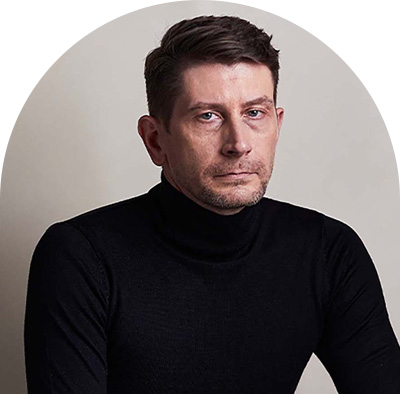
Marek Kvetan
Of all the artists in our exhibition, Marek Kvetan (1976) is probably the most 21st century artist. In terms of his style and social role, Kvetan can be seen as heir to the British generation of YBAs, whose ecosystem is the middle class and its situational doubt, and whose visual reference is commodity fetishism. Kvetan has been one of our most media-literate artists from as early as the 1990s. He knew how to employ and enjoy media, but also artistically misuse it. In addition to video art and digital graphics, he has exhibited objects and installations, often based on repurposed ready mades. Kvetan has never been an artist of big themes, rather of situational issues (media criticism, multiculturalism, information overload, institutional and corporate criticism). His work is chameleon-like and extremely flexible. That is why it also resonates so well at thematic exhibitions. Because it is always present in the “here and now”. Marek Kvetan is a contemporary artist in a good way. His work is neither escapist nor romantic, but quite pragmatic in a sense. Kvetan’s postmodernism does not have any a priori themes or a fixed medium, which often surprises us at exhibitions. And delights! His artefacts are beautiful in form, sometimes literally shimmering or just glamorous, nearly high-end in design, but always with a slightly ironic overlap, or an alienation from the (apparent) design. Compared to similar, albeit artistically more vulgar colleagues, Kvetan appears to be an artist of particular media intelligence and sensible visual gestures.
Echo
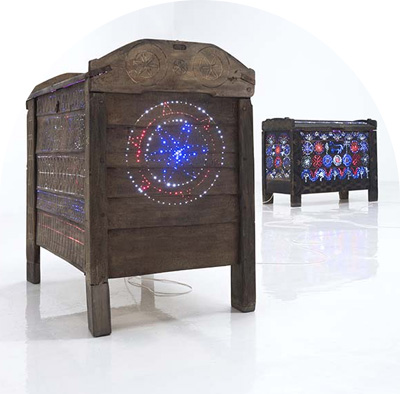
Echo
Marek Kvetan’s light and sound installation, Echo (2017), is not quite typical for the context of his work, although it shares some common features. From the proverbial interpretation of kitsch, cheap glitter, the use of antiques, DIY aesthetics, situational humour, bizarre encounters, and criticism of consumerism and hoarding, he has moved on to interpreting material objects of the distant past. As its basis, he used objects from our ancestors, which he carefully transformed as an author with the soul of an antiquarian and collector. The objects are coffers from the late 19th and early 20th century, which ethnographers classify as a specific type of the so-called marriage coffers, given to the future bride by her father as a part of her dowry. They represent ceremonial objects in folk tradition, imparting a strong meaning of gender. The choice of the object, but also the musical composition inspired by folk music, allows us to feel nostalgia for authenticity, for the traditional crafts and materials, and for our customs, alienated behind the layers of the digital age. He revives the old with new technologies, and showcases the local in a global manner. A common feature of his installations is artificial lighting using neons, fluorescent lamps and LEDs. Kvetan is quite literally “obsessed” with light art, with Echo paying homage to his earlier works – the lesser-known Ark (2014), and the legendary Carpet (2008). Alongside the fairy-tale, mystical or even psychedelic experience, this installation reminds not only of the mysterious content of the past, but also is a reference to the funeral casket, the final vessel and the absent body. The musical component was created in collaboration with S. Stračin and J. Ďuriš.
Prologue
Prologue
The Slovak National Gallery is opening its renovated premises! Come and experience the first ever exhibition on the new premises of the Slovak National Gallery. There are twelve thematic exhibition settings awaiting you. You will see works of old, modern and contemporary art through the scope of mutual dialogues, and more (or less) surprising relationships. Through unconventional combinations of works from different historical periods, you will look back at the gallery’s acquisitions over the past 30 years, allowing its collections to be shown in all their diversity. At the same time, the large installations will lead to the upcoming permanent exhibitions, which will be gradually accessible from 2023.
12 Colours of Reality
12 Colours of Reality
The impressive installation made of twelve colourful balloons by Stano Filko, titled RETROOQS.F. 12 Colours of Reality, commands the space of the future permanent exhibition of Contemporary Art. As its thematic counterpoint stands the motif of the Last Supper by the woodcarver Pavol Gross, Snr. of Spiš. The last moments between Jesus and his twelve disciples evokes a symbolic turning point – a transformation that opens the door to new experiences.
The exhibited works are also intertwined by the motif of love – as the principle, meaning, and life force of a person. This connection will be further highlighted with a dance performance by choreographer Petra Fornayová, invited to interpret the work by Filko. According to one of the author’s statements, the work could also have had an alive character as a manifesto of love. The Complementarity performance act sprang from this impulse as an independent piece that enriched and enlivened the installation.
The installation is part of the 12 Colours of Reality – RETRQ = HAPPSOCSF project, continuing the artist’s earlier works from the HAPPSOC series (Happen Society, happening sociologique). Stano Filko, along with Alex Mlynárčik and Zita Kostrová, first “appropriated” spaces, everyday objects and parts of experienced reality through their conceptual piece HAPPSOC I. (1965), which they have since regarded as works of art. In doing so, their creativity not only defied the totalitarian ideology dominating people’s lives, but they also expanded on the perception of everyday reality as a form of art.
The balloons in the colours of the twelve chakras of Filko’s cosmological system were originally intended for the outdoors. Inside the exhibition hall, they act as metaphorical bodies, filling the newly opened Slovak National Gallery (SNG) building with a brand-new breath of air and spirit.
Pavol Gross Snr. (*1618 – †1688) led a sculpture workshop in Spišská Sobota, where his own son Pavol also worked. He also worked on Church commissions around Poprad and in Levoča. He was thus inspired by the art of the opaque transition between late Gothic and Renaissance, at that time still a living part of many Spiš churches. The Gross family ran one of the most productive workshops of the early Baroque period, even beyond the regional context.
Stano Filko (*1937 – †2015) is an internationally recognized Neo-Avant-Garde artist, who worked in Slovakia but also in Düsseldorf, Germany, where he emigrated in 1982 already as an established artist. From there, he moved to New York, where he worked until 1990. After his return to Czechoslovakia, he worked intensively on developing his universal cosmological concept, the System SF, in which he organised his entire life’s work based around topics and colours.
Petra Fornayová (*1972), author, performer and choreographer, is one of the most prominent names on the independent theatre and dance scene. She has been a member of several artistic groups, and has collaborated with prominent creators in contemporary theatre, dance, visual arts, poetry, literature and music. Her work across the recent decades transcends the boundaries of the known types of art and their genres.
Bright Past
Bright Past
The Tableau Vivant (French for “living picture”) is one of the traditional genres in the history of art. A group of costumed protagonists stages a scene – a historical event or, as in our case, an already existing painting. In the world of Action Art following World War II, the Tableau Vivant has made a comeback as a specific form of performance art.
Vladimír Kordoš and his colleagues from the School of Art Industry in Bratislava paid homage to Raphael’s famous fresco The School of Athens (Vatican, Stanza della Segnatura, 1509 – 1511). The original painting brought together eminent ancient philosophers, mathematicians and other scholars. Leonardo da Vinci, for instance, appears in it as Plato, and Michelangelo as Heraclitus of Ephesus. In this way, Kordoš – with a healthy dose of self-irony – stages “our own” little Parnassus in his video, which he found at the School of Applied Arts (ŠUP) thanks to the liberal atmosphere of the educational institution. Even after all these years, the video performance serves as a reminder of one of the rare “islands of positive deviance” standing out from the grey sea of boredom and mediocrity of the declining totalitarian regime.
In contrast to this artistic mythology stands a collection of old portrait photographs. They approach the topic of forgetting, or its opposite – that of memory – in a similar manner, albeit more directly. In the 19th century, photography became a new tool for faithfully capturing the human form. Thanks to photography, a person’s face will be “frozen in time”, so to speak, for eternity. Despite their novelty, however, early portrait photography relied on the time-honoured rules of figure composition, as cultivated for centuries by classical art, painting in particular.
Each of the exhibited photographs holds the essence of a Renaissance portrait, although not as obviously as the work of Vladimír Kordoš. Here we find echoes of busts, half and three-quarter figures (“Kniestück”). It wasn’t until the artistic Avant-Garde of the early 20th century that photography was freed from its dependence on the established compositional principles of the past.
Vladimír Kordoš (*1945) is a leading Slovak multimedia artist. He studied in Bratislava, first at ŠUP, and later at the Academy of Fine Arts and Design (VŠVU) in the medium of glass. His diverse, genre- and media-rich body of work often paraphrases famous paintings of Old Art, which he reinterprets and often inserts parts of himself into them. Kordoš was one of the first protagonists of Action Art in Slovakia and participated in many legendary events of the underground scene, including the 1st open studio of Rudolf Sikora.
The Collection of the Oldest Portrait Photographs in the Slovak National Gallery (SNG) has been forming gradually since the very beginnings of its Collection of Photography. It maps the activities of the most significant studios in Bratislava, but also in smaller regional towns. The Collection contains several hundred portraits, the oldest of which date back to the period from 1860 to 1862, also serving as a record of the early development of the medium of photography in Slovakia.
Your Face
Your Face
The depiction of the human face has occupied a position of privilege in the history of art since its very beginnings. The genre of portraiture has gradually crystallised from the tomb monuments of Ancient Egypt, through the sculpture and painting of Medieval Europe, to the myriads of paintings and sculptures of today. After all, even a simple passport photo is a legacy of this cultural evolution. However, identifying a person by their likeness is now giving way to other methods, including the collection of biometric data, like fingerprints and DNA samples.
In recent years, the Slovak National Gallery (SNG) has purchased several works attributed to the phenomenal Baroque portrait painter Jan Kupezky. Other works by Kupezky have been restored by the gallery, and some have even had their authorship attribution changed as a result. The Kupezky Collection has thus become an art history arena, being host to the struggles between curators, collectors, restorers, and chemists. We are dedicating a special exhibition to these “struggles” in the near future.
These representative Baroque portraits are facing a contemporary series of paintings Duška I. – XIV. by Róbert Bielik. It depicts the progress of his grandmother’s neurodegenerative disease. The woman’s gaze is sometimes focused on her grandson painting – and therefore on us; more often, however, she just stares blankly into space. Through her gaze, the author tried to capture the gradual forgetting of family and friends, the departure from the world perceived by the senses.
The contrasts between the “present”, almost defiantly focused gaze of the Baroque society male elite, and the “absent” gaze of an old, yet at the same time beloved woman, suggest more than just a contrast between the public and the private. With more time passing, they also testify to the changing purpose of portrait painting. Or are there similarities in the portraits by Bielik and Kupezky to be found after all?
Johannes Kupezky (Jan Kupecký *1666 – †1740), born to Czech parents, spent his childhood in Pezinok and later completed his studies in Vienna. His travels to Italy, especially to Venice and Rome, marked his entire later work. He became famous as the portrait painter of important European noble families, especially the House of Liechtenstein, but also members of the Viennese Imperial Court. At the end of his life, he worked in Nuremberg – a city that, as an evangelical, provided him with a more tolerant environment than Catholic Vienna.
Robert Bielik (*1963) studied at the Academy of Fine Arts and Design (VŠVU) in Bratislava. He is influenced by the tradition of Realist painting, and still prefers the classical technique of oil on canvas. The plot of his paintings, however, often contrasts sharply with their realism and technique. Bielik likes to toy with the audience’s attention and prejudice, often leaving even a well-informed audience and art critics confused. In addition to painting, he also dedicates his time to literature and journalism.
Being in Nature
Being in Nature
The topic of nature has been used as a metaphor in art since the late Middle Ages. It first manifested itself in the artistic descriptions of pilgrimage sites, or the Holy Land. Renaissance artists later focused on the study of nature itself, and capturing landscapes became an independent genre. However, it was not until the painters of English and German Romanticism, such as John Constable or Caspar David Friedrich, that we started paying attention to the specific relationship between man and nature. An individual – often the author themselves – is confronted with nature, largely wild and untamed. From this period onwards, nature also acts as a depiction of human destiny – a place where one is free to experience all of one’s identities, being an organic part of it themselves.
The dialogue between two painters, Mednyánszky and Dúbravský, is not entirely fictitious: Andrej Dúbravský studied paintings, sketches and diaries by Mednyánszky intensively, and wrote commentaries on them on several occasions. Ladislav Mednyánszky used landscape painting primarily as a vessel for his experiments with the subjects of several contemporary artistic schools – from Symbolism, through Impressionism to the beginnings of Abstract Art. The expressive and sketch-like nature of paintings by Dúbravský shows in particular his artistic temperament and sensual openness (and quite often his private parts).
In stark contrast to the works of both authors, we have juxtaposed the glass paintings of mountain massifs by Žofia Dubová. The author’s backdrop-like compositions are still based on the landscape profile, but begin moving further towards Abstraction. In this regard, her artistic approach is closer to Mednyánszky, with several generations standing between them, than to the flamboyant egomania of her older schoolmate.
Ladislav Mednyánszky (*1852 – †1919) was perhaps the most famous Hungarian and Slovak painter from the turn of the 19th and 20th century. True to the “Zeitgeist”, he would most likely have described himself as a cosmopolitan person today. He worked in several locations across the Austro-Hungarian Empire, he was home both in Budapest and in Vienna, while also often staying in Munich, but also in Spiš. He dedicated his efforts equally to landscape painting and portraiture. He was strongly affected by the scenes from the front lines of World War I, which he captured as a direct witness to the events. The Slovak National Gallery (SNG) manages a substantial part of the painter’s estate, and exhibits most of his works in the Strážky Mansion – originally owned by the artist’s family.
Andrej Dúbravský (*1987) is a graduate of painting from the Academy of Fine Arts and Design (VŠVU) in Bratislava and a laureate of several art awards, including the VÚB Foundation Award for Painting. Starting with his early works, which captivated the public with their undisguised homoerotic themes, he has gradually worked his way to landscape and garden motifs. These seemingly sensual paintings often contain an uncompromising critique of the devastation of nature and industrial food production.
Žofia Dubová (*1991) studied both painting and glass at the Academy of Fine Arts and Design (VŠVU) in Bratislava, and completed internships in Portugal and the United States during her studies. She works almost equally with both art types and enriches them with diversions to textiles. The material becomes part of the message in her work. She enjoys pushing the medium of painting with her unconventional experiments, only to come back and reaffirm and revive it.
Public Body
Public Body
Pietà – a statue of the Mother of God holding the body of the dead Christ in her lap – became established in the 14th century as one of the key themes in Gothic art, despite not referencing any explicit biblical source. On the contrary, its popularity was related to the spread of various, until then marginalised forms of worship, practised in private rather than in the Church temples.
In the late Middle Ages, the motif of the pietà becomes primarily associated with the Devotio Moderna movement, emphasising the individual approach to faith, religion and the study thereof. Thanks to its “extra-biblical” origins, the base form of the pietà remained practically unchanged until the 20th century. The present exhibition will pay special attention to the latter phase in the development of this subject.
The juxtaposition of a sculpture by Ján Zelinka with folk pietàs represents the two extreme positions of the future permanent exhibition of Religious Art. The wooden statues meant for folk worship meet a monumental concrete sculpture by a contemporary artist. This installation puts emphasis on the body as a carrier of meaning. The naive poetics, and almost serial repetition of the form of suffering in the Šaštín Pietà, clashes with the “art-breaking” sculptural gesture, unique in Slovak art for its directness, material and stark expression.
The future exhibition will display the finest Gothic and Baroque sculptures and paintings from the collection of the Slovak National Gallery (SNG). However, there will also be several entries from different time periods. Through them, we will attempt to expand the concept of (not only religious) art beyond the boundaries of traditional media and “time-tested” quality.
Ján Zelinka (*1978), having studied at the Faculty of Arts of the Technical University of Košice (TUKE), and completed a study stay at the Academy of Fine Arts (AVU) in Prague, finished his education with a doctorate from the Academy of Fine Arts and Design (VŠVU) in Bratislava. He works with various forms of monumental and interior sculpture, and experiments primarily with inverted relief modelling in materials such as concrete, plaster or lead. His iconography is dominated by the topic of death, respectively the transience of life.
The Collection of Folk Pietàs is part of the SNG Collection of Naïve Art, containing works by amateur artists of the 20th century, but also crafted artefact by anonymous authors, as well as “marginal” phenomena of artistic creation including Art Brut, Outsider Art, etc. However, in various exhibition confrontations, this collection – somewhat paradoxically – also helps to understand the dominant forms of art, whether historical or contemporary.
Community of Women
Community of Women
The aquatic installation offers a visual experience expressing the strength of women, the subtle power of caring and solidarity. A multitude of red bras stitched into the shape of a jellyfish float inside the atmosphere of blue “undersea” light. The soft sculpture Medusa was originally created by Emőke Vargová as a site-specific installation for an exhibition in the Šamorín Synagogue, where it hung as a huge chandelier from the ceiling of the upper gallery, which had been historically reserved for women.
The author works thoughtfully using textiles, sewing, quilting and layering fabrics. We see the pieces of clothing intended as covering – to hide the female body – multiplied, intertwined, and functioning as a single organism. They symbolise a kind of sisterly social superorganism – a Community of Women forming a solid support base and, so to speak, a safety net for the everyday life of society.
The crises and wars of our time are affecting us ever more closely, and we realise that it is mainly the women who have become unwilling participants in these events. However, the burden of mutual survival, and preserving the hope of our society for the future often rests on their shoulders.
Ester Šimerová-Martinčeková skilfully captured in her paintings the uncertainty and anxiety from the impending catastrophe of the approaching World War II, but also the determination and quiet strength of women. The Expressive painting Woman with a Rooster was created at a time when our most important Modernist artist returned to the human body, and more intimate subjects. Through her authentic expression, she searched for connections between domestic rural Modernism, and her experience with Cubo-Futurism during her study stay in Paris.
Ester Šimerová Martinčeková (*1909 – †2005) was a prominent name of interwar Modernism art. She studied at the Académie Julian in Paris, and at a private school run by the leading Ukrainian Avant-Garde artist Alexandra Exter. The two shared a lifelong friendship. Her life was marked by World War II, and later by persecution during the totalitarian regime. As a representative of the so-called Generation 909, her richly complex oeuvre spanned from Realism to Cubo-Futurism and Abstract Art, while she also worked in scenography and jewellery.
Emőke Vargová (*1965) is a multimedia artist who erupted onto the scene in the 1990s. Her bold artistic production is based on the female perspective in painting, objects and installations. She often uses the expressive possibilities of soft textile sculpture, and the “traditionally feminine” handicraft. For many years, she has been teaching as Docent (Reader) at the Division of Drawing of the Academy of Fine Arts and Design (VŠVU) in Bratislava.
Stability Assured
Stability Assured
Works of art hold different characteristics and can be perceived from different perspectives. This installation focuses on the material substance of works of old and contemporary art that have – at least at first glance – nothing in common with each other. And yet, with few exceptions, the material and construction form a key part of almost every work of art. Their primary function is often that of a “carrier” or “support”, but the message of the art object itself can also derive from them at times.
The architectural monuments by Michal Moravčík and Štefan Papčo play with the basic – only partially authentic – materials of common buildings in the Slovak countryside and the Socialist flat. Papčo rips out a piece of utilitarian rural architecture from the original whole, and elevates the gable of a wooden barn to “fine” art. Moravčík creates a kind of interactive trellis out of cheap modular furniture, thus making a humorous commentary on its original function, value and durability.
In contrast to the two contemporary objects stand the paintings of the “old masters”, displayed from both sides. We want to draw attention to the construction of these paintings, their stretcher bars, and the stabilising aids used in panel paintings – the so-called parquetry. On the one hand, this joint installation questions the established exhibition formats; on the other hand, it celebrates the gallery space as a platform for critical, social and architectural thinking.
Štefan Papčo (*1983) studied sculpture at the Academy of Fine Arts and Design (VŠVU) in Bratislava and completed several study stays abroad, including in Barcelona and in Porto. He is among the most frequently exhibiting and established Slovak artists abroad. Mountains and mountaineering are some of the key themes in his sculptures and installations – from naturalistic figure sculptures to video recordings, video performances and sign systems.
Michal Moravčík (*1974 – †2016), a Slovak artist who left us too soon, was a graduate of sculpture from the Academy of Fine Arts and Design (VŠVU) in Bratislava, and a main figure in the artistic movement of the so-called Social Sculpture. His sculptures and installations were mostly reimagined “ready-mades” that posed an ironic commentary on certain political phenomena and social movements of early democracy in Slovakia and Central Europe. Moravčík manifested his interest in the public discourse and the public space via numerous civic and artistic initiatives.
Parquetry (tech.) is a supporting structure secured to the back of wooden panel paintings. It absorbs microscopic movements – contractions and expansions – of the individual boards making up the wooden panel, caused by changes in temperature and humidity. This prevents the fragile layer of the paint from being disturbed.
Stretcher Bar (tech.) is a part of paintings on canvas. Unlike the frame, it is usually not visible on conventional display. It serves mainly to keep the canvas stretched, and thus protects the layer of paint on the face of the painting. Stretcher bars can take different forms depending on the shape and format of the painting, but their basic structure rarely changes. Like parquetry, stretcher bars often carry a wealth of other information – collection labels, records of past display or restoration of the painting.
Pain on the Stage
Pain on the Stage
Cultural values can be born from the suffering of individuals, which can often trigger a form of social purification. The voluntary endurance of pain and the premature death of Christian saints and martyrs, who suffered for their faith, have been extremely salient moral role models since the early Middle Ages. Pain stirs the emotions in a crowd, and can become a tool for revolution, but also for propaganda.
The 17th-century series of copperplate engravings by Gerard Bouttats depicts the torture of Catholic missionaries, such as the Jesuits in Japan. Victims were often dying for several days, during which they were forced to renounce the Christian faith. Back home in Europe, however, these images were meant to spread the message that the Church, and the Holy Roman Empire, will persevere at any cost, paid for even by the blood of the Saints. The missionary efforts and their political background are of interest to Postcolonialism studies in many ways today.
On the other hand, people in the Modern Era continued to die for their personal convictions, or for daring to pursue Reformist ideas within the Church, science, art or in life. In the 16th and 17th centuries, Europe was embroiled in witch hunts, during which the Inquisition tortured and executed tens of thousands of “inconvenient” people for alleged witchcraft and consorting with the devil. Women suffered in particular, falling into the hands of the executioner for actions exaggerated by superstitious and uneducated people.
Chair for Guest by Jana Želibská treats public space as a place for self-revelation, and the bearing of potential consequences. Its title references a vapid TV show broadcast in Czechoslovakia since 1980. The author contradicts the toxic optimism of this talk-show with the stark object resembling an instrument of execution. It thus opens the topic of the martyr-like triumph over one’s own body. In the current mass media era, public criticism of patriarchy, uncompromising defence of freedom, and one’s own identity, gender, sex and place in society, are examples of what is also becoming “martyrdom”.
Gerard Bouttats (around *1630 – around †1668) was a Flemish draughtsman, engraver and printmaker. He apprenticed in his father’s workshop in his hometown of Antwerp, and later moved to Vienna, where he worked for the rest of his life. Bouttats worked mainly as an engraver of portraits, and, to a lesser extent, of allegories, landscapes and battle scenes, and calendars. Most of his works were based on designs by other masters, but he singularly created the Martyrs series, one of his most famous works, from the model to the engravings.
Jana Želibská (*1941) is a prominent protagonist of Neo-Avant-Garde art, whose Environments – artistically created spaces – gave voice to the missing feminist perspective on the Slovak version of Pop Art and Neo-Realism in the 1960s. With that, she has become an internationally significant name and has exhibited in many prestigious galleries around the world. She has also worked in Action Art, Conceptual Photography and Video Art. In recent decades, she has mainly created objects and installations, including the post-apocalyptic vision of Swan Song Now for the Czech and Slovak Pavilion at the 57th Venice Biennale in 2017.
Beautiful Chaos
Beautiful Chaos
The pair of exhibited photographs can be aptly described as industrial, or even “construction” still life, although art historians do not work much with this term. This black-and-white shot by Ondrej Nosál offers a glimpse into the construction site that was the Slovak National Gallery (SNG) during the first reconstruction of the Water Barracks in the 1970s, before the construction of the so-called Bridge. The boarded statue of the painter Peter Michal Bohúň is surrounded by randomly scattered construction material against the backdrop of the half-demolished Barracks on the Danube embankment.
It creates a kind of absurd tension between celebrating the past and the promise of the future. In retrospect, it seems that this optimistic promise has been fulfilled – after all, the gallery has been renovated for the second time since then, and even the statue of Bohúň has survived intact. The truth is, however, that SNG has spent nearly half of its existence in a state of limbo and – almost literally – as a construction site.
A different form of transience, although with similar props, is captured in one of the photographs from the Field Trip. Israel. series by Martin Kollar. He created it in the territory of the West Bank of Jordan during a scholarship stay. He described its defining emotion as a constant sense of danger. Moving along the border between the two sides frozen in armed conflict, accompanied by constant security checks, reminded the author of his childhood spent behind the Iron Curtain.
The photograph by Kollar – “cut off” from the author’s original series by being purchased for our collection – has immortalised this tension in the form of an improvised street barricade, giving the impression of a child’s construction set. However, it might be showing a part of an army checkpoint that was left beyond the camera’s view, out of the photographer’s direct interest.
Ondrej Nosál (*1938). This Slovak documentary photographer recorded the rapid progress of the industrialisation of Slovak towns and countryside throughout the 1970s and 1980s. He was not so much concerned with its ecological or social consequences, but was mainly interested in the dramatic entrance of new architecture into a predominantly rural environment. Later, he shifted his focus to Socialist rituals such as May Day parades, but he also created more intimate cycles from his own family environment.
Martin Kollar (*1971) is a cinematographer, film director, producer, and one of the most influential Slovak photographers. He graduated from the Film and Television Faculty of the Academy of Performing Arts (VŠMU) in Bratislava, and has worked on several internationally awarded Slovak films as a cinematographer. Since the 1990s, he has been exhibiting at collective and individual exhibitions, especially abroad. His photographs seek an extraordinary perspective on ordinary situations. At the same time, however, they can embody a sense of contrast, often with an ironic overtone, that elevates seemingly routine circumstances into more universal visual metaphors.
I, Cosmos
I, Cosmos
We look back at the joyful era of space exploration as a long-lost illusion. During the “golden” sixties, a society of humans that was righteous and prosperous still appeared within reach. However, this enthusiasm gradually faded in light of the failed student revolutions in the West, and following the Soviet occupation in 1968, which cemented the Iron Curtain in the East. Dreams of “impregnating space with one’s aura” (Yves Klein), or of a so-called anthropic universe that understands itself (Rudolf Sikora), have left us disenfranchised by the ruthlessness of global and domestic politics.
The Stele for Every Planet by Juraj Meliš is an expression of seeing the visions of a brighter tomorrow die. The work is part of the Monologues cycle that makes use of prints of the author’s face. We are faced with an image of a man who no longer looks up to the stars, instead staring downward with a sad look, because there is no escape for humanity from the Earth. According to the French philosopher Bruno Latour, our imaginations no longer reach into the depths of space, and our imaginary progress no longer moves further beyond (plus ultra), rather further inward (plus intra), back home to the planet we all share. However, in what geologists are calling the Anthropocene – the Age of Humans – the Earth is becoming an increasingly hostile place to live thanks to human activity.
The work of András Cséfalvay imagines the cosmos as a kind of mythological arena, where fights for its spiritual essence are taking place. It is a universe centred around man – it embodies the boldness of human thoughts and visions, but also reflects everyday frustrations and nightmares. In the video titled New Horizons II, Cséfalvay appears to mirror himself in the various characters, and conducts an internal dialogue with them about the bridges between art, religion and science. The portrayed discourse was inspired by the New Horizons spacecraft, launched in 2006 to explore the (non)planet Pluto, which is the main character in the story of judgment and condemnation.
Juraj Meliš (*1942 – †2016) combined the methods of traditional interior and monumental sculpture with elements of New Realism, Pop Art and Conceptual Art. He was active predominantly in the underground art scene during the previous regime, and subsequently also as a long-time professor at the Academy of Fine Arts and Design (VŠVU) in Bratislava.
András Cséfalvay (*1986) moves between media with freedom – he works with painting, objects, installations, video, as well as with text, music and sound. He often employs game development and 3D animation. His work explores historical and scientific facts in terms of aesthetics and various philosophical ideas.
Other Worlds
Other Worlds
We exist on the same planet, Earth, yet we inhabit different worlds. Recognising and cultivating these worlds, with sensitivity and respect for their differences, are among the most pressing social issues today. The Planetary System by Pavla Sceranková depicts a model of individual human life, with a web of ideas and relationships that need to be constantly created, nurtured and shared.
The Sun at the centre is not missing by accident – after all, the central element around which the planets revolve is our own self. The cosmic imagery in this piece is related to the search for sources of inspiration in our inner world, in the immense depths of our personal universe. The surface of the rubber planets is covered with woollen yarn, which we can shape ourselves by knitting.
For centuries, scientific and artistic visions of the universe have relied on commonly held ideas, but also on the imagination of their inventors. They united grandiose images of an infinite space full of unknown worlds and beings, as well as the metaphysical longing of man for the transcendent meaning of life. The graphic prints by Johann Melchior Füssli illustrate the fourth day of creation from the Book of Genesis. Genesis tells how God ordained lights to separate night from day, and to mark the seasons, days and years.
The author’s artistic rendering of the biblical origin of the universe is accompanied by cosmological diagrams of the movement of celestial bodies as described by the famous astronomers Ptolemy and Copernicus. They come from a set of 762 illustrations by Füssli found in the gigantic encyclopaedic opus called Physica Sacra by Johann Jakob Scheuchzer, who had the ambition to connect religion and knowledge of natural science.
Johann M. Füssli (*1677 – †1736), a prolific Swiss artist, draughtsman and printmaker, who became well known for his illustrations accompanying various writings by the polymath Johann Jakob Scheuchzer – appearing in Physica Sacra, and also in Helvetiae Historia Naturalis. He portrayed a wide range of subjects, from sacred motifs and landscape to natural history themes.
Pavla Sceranková (*1980), a sculptor and conceptual artist, whose sculptures, objects and installations challenge the traditional sculptural methods. She is fascinated by the active involvement of the audience, interactivity and the passage of time. Her videos link sculptural practice with performance art. She draws inspiration from everyday objects, unexpectedly transforming them into unexplored thematic and spatial contexts.
Ordinary Apocalypse
Ordinary Apocalypse
Waiting for the looming end of the world has never ceased to capture the human imagination. Religions and mythologies tell stories about the creation of the world, as well as its end. The Apocalypse, as told by the Revelation to St. John in the New Testament, is one of the most prominent visions within our cultural milieu. It describes the signs and events of the last days of mankind, and the coming of the New Age.
The Last Judgment delivers final justice in the form of salvation or damnation. However, the Apocalypse is more than just a religious topic. We find apocalyptic ideas in the backdrop of our society’s relationship to time and progress, in our cultural wars and political systems. Most conspiracy theories spreading across the fertile soils of social media in the current, so-called post-truth era, make use of them. Apocalypse hides behind the interpretations of history calling for final and “cleansing” destruction – through wars, conflict and upheaval. It often serves as an excuse for political aggression, hatred and genocide.
Albrecht Dürer created his influential graphic cycle at the turn of the 15th and 16th centuries, a turbulent time embroiled in fear of the end of the world, proselytised by various sects and self-proclaimed prophets. As Europeans discovered the New World, efforts to reform the church matured on the old continent. The boundaries of human imagination have shifted, but they have also brought new uncertainty. Dürer illustrated the mystical events of Revelation in marvellous detail, but the fact that he staged them in his present using scenes and costumes is no coincidence.
The post-apocalyptic installation titled Dramasks by Radovan Čerevka originates from the tradition of historical diorama as a museum exhibit. Here, African masks, along with fighter jets, become phantoms – revered idols belonging to a new cult. The work illustrates a fictional historical event and its consequences. It warns of the threat of biased historical interpretation, propaganda, and abuse of the innate human need to seek some higher, drama-filled meaning of one’s own life.
Albrecht Dürer (*1471 – †1528) was the most prominent painter and printmaker of the so-called Northern Renaissance. He worked almost his whole life in Nuremberg, but benefitted greatly from trips to Italy and the Netherlands. He reinvented the traditional foundations of portrait and religious painting, combining both genres in several self-portraits. His woodcuts and copper plate engravings, illustrating Books of the Bible and subjects like the Passion, the Life of the Virgin Mary and the Apocalypse, were printed and copied many times following their creation. Dürer also authored numerous drawing and watercolour studies of nature and landscapes. He left behind a vast body of theoretical work that influenced generations of European artists.
Radovan Čerevka (*1982) creates objects and installations utilising various forms of post-production – additional alteration of found visual or physical material. He compiles data and evidence from military conflicts, information wars, manipulative intelligence games and hoaxes.